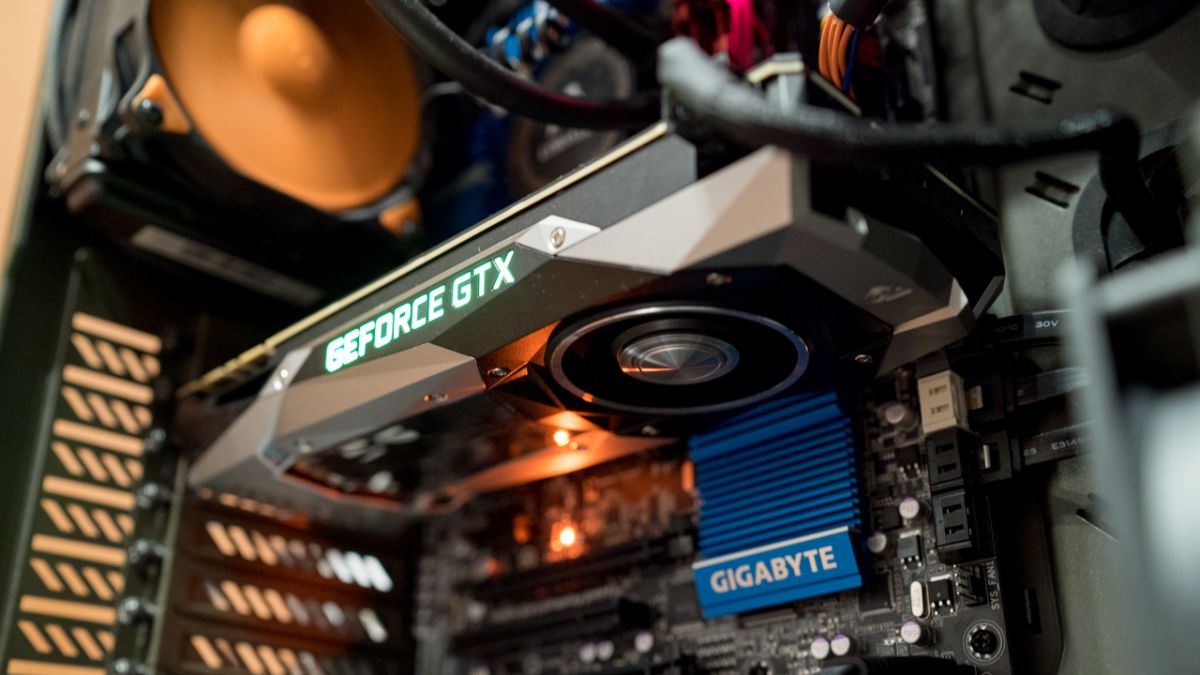
Introduction and design
Update: We’ve updated our hands on impressions of the Nvidia GTX 1080 with a full review and benchmarks. Also see the difference between the Nvidia GTX 1080 vs GTX 1070 now!
Nvidia’s latest Pascal GPU architecture has been on the tip of every PC enthusiast’s tongue for more than a year. And with good reason, this is the first time we’ve ever seen an architecture based around a manufacturing process smaller than 28nm.
Almost as small as Intel’s new 14nm Skylake processors, Pascal introduces Nvidia’s 16nm FinFET process and the company’s next generation GPU architecture. And with that comes improved efficiencies, higher densities of transistors, and increased performance. Enabling us, the players, to enjoy AAA games at higher frame rates, improved VR experiences and to push greater resolutions ever possible before.
Or at least that’s the theory.
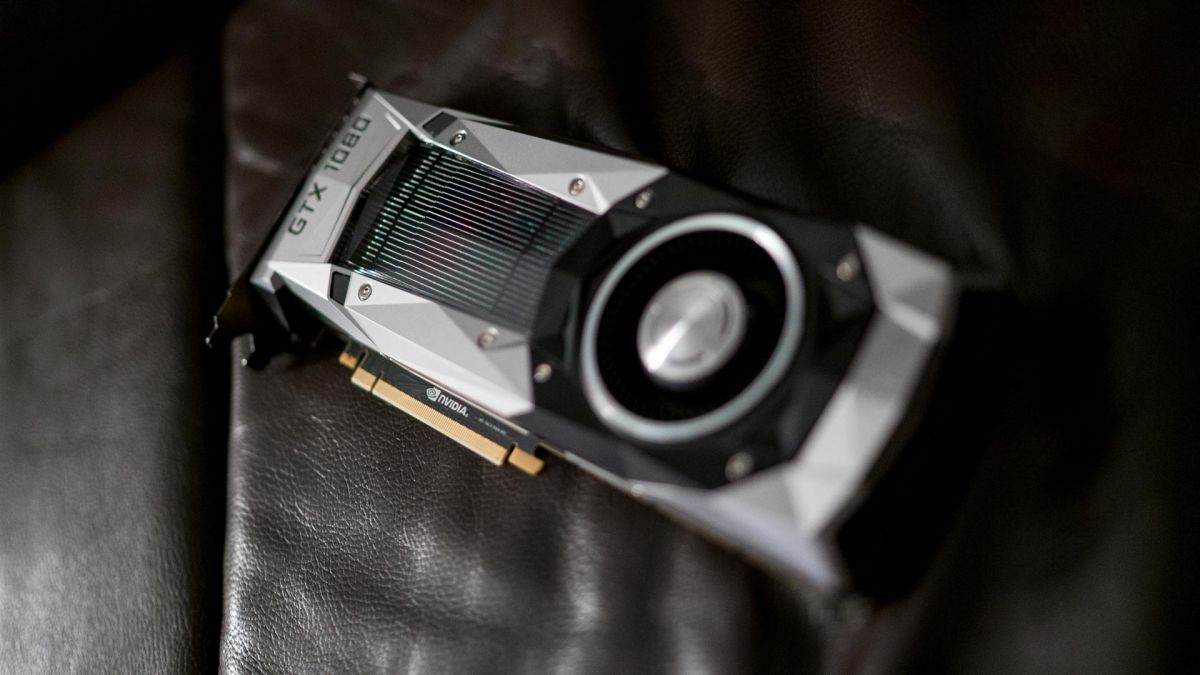
Power up
At last I finally have my hands on Nvidia’s latest and greatest GPU, the GeForce GTX 1080. Coming jam packed with 2,560 CUDA cores, 160 texture units, 64 ROPs, 8GBs of Micron’s latest GDDR5X VRAM, and a GPU boost clock running in at a comfortable 1,733 MHz, is there any wonder why the PC enthusiast community is so abuzz?
For those less savvy with the technical jargon, the best way to compare these cards is simply by looking at how many TFLOPs they can produce. The GTX 980, manages a respectable 5.5 TFLOPs, the 980 Ti, 6.5, the Titan 7.
And the GTX 1080? 9.
Yep, in essence it should be almost twice as powerful as its predecessor, and in nearly every scenario, it is. At least in our testing. So let’s get to it.
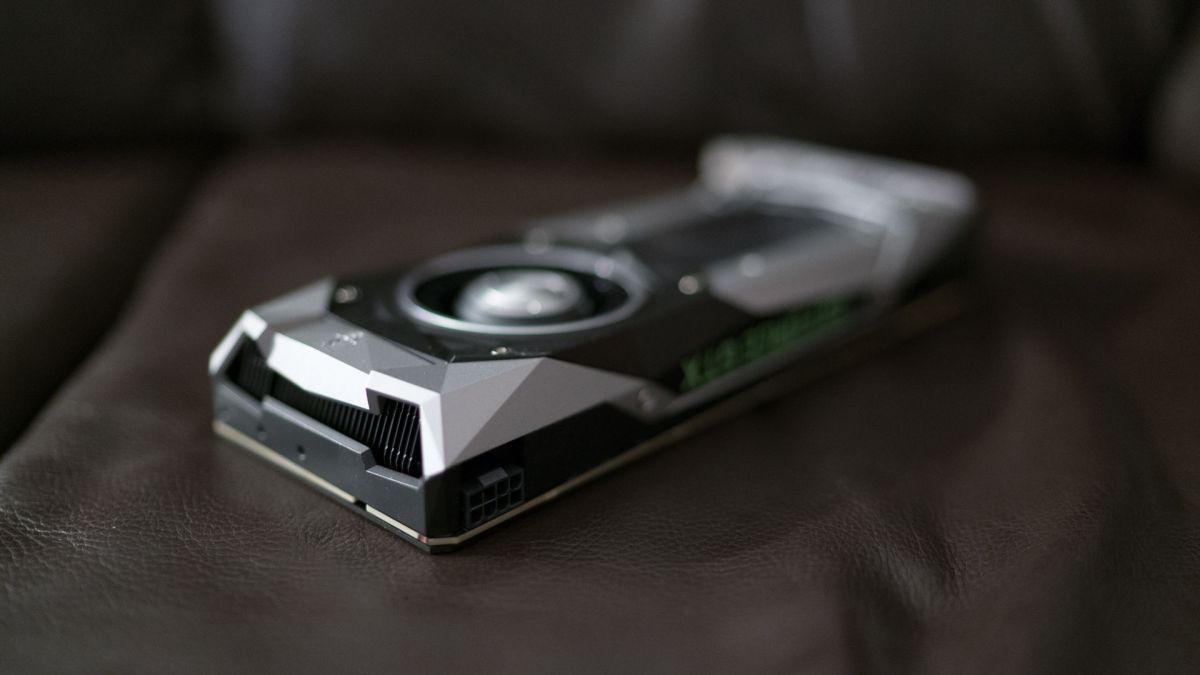
Design and cooling
Overall it’s a cool card. Not as cool as some of the GTX 980s we saw two years ago, but it still remains at a chilly 82 degrees C, or 91 if you bump the power limiter up, and let GPU Boost have access to that extra headroom. Overall it falls well within operating parameters.
What is interesting about this card in particularly, is the inclusion of the DisplayPort 1.4 connection standard. The biggest limiting factor currently with 4K gaming, is the lack of higher refresh rate monitors. DisplayPort 1.2 is limited to pumping out 3840×2160 at 60 Hz, meaning the buttery smoothness of 144Hz gaming panels has been unobtainable on higher pixel density screens.
Although there’s no 4K 120 Hz panels out on the market just yet, Nvidia claims two 1080’s in SLI will be able to push 4K resolutions at 144 Hz. DisplayPort 1.4 also supports resolutions as high as 8K (7680×4320) at 60 Hz with HDR, or 4K at 120 Hz with HDR.
It won’t be long until all of our high-end monitor dreams are satisfied.
Performance
The biggest conundrum the 4K Ultra HD early adopters have had was finding a suitable graphics solution to power those pretty pixels. 8,294,400 dots of resolution is no small number. And to try and render everything at 60 frames per second in some of the latest and greatest AAA titles requires some serious processing power.
In most cases the best solution was to opt for multi card setups. It’s not uncommon to see dual Nvidia GTX 980 Ti’s, AMD Fury X’s or other bonkers solutions rigged together to bring this buxom beast to bear.
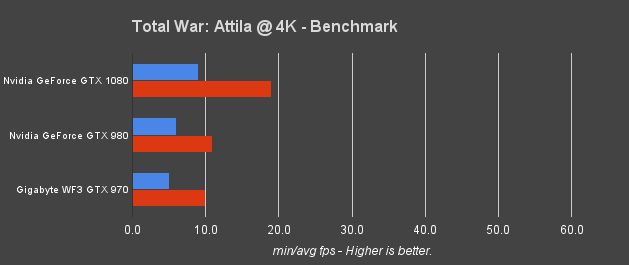
However, the problem with this lies in how both Crossfire and SLI operate. Namely, it requires support from each and every title’s game developers.
Take Total War for example. Want to play Attila at 4K with an SLI profile? Too bad, they don’t exist, your extra £400 card just became a paper weight. And that’s why, amongst other reasons, a single card solution is so enticing.
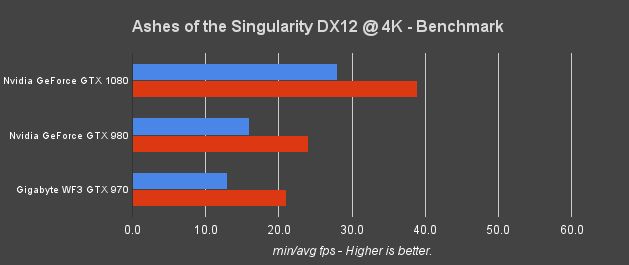
Does the GTX 1080 deliver on that promise?
Well yeah, in our testing Far Cry Primal, The Division, and Ashes of The Singularity all performed exceptionally well at 4K, with average frame rates well into the 40s. Rise of The Tomb Raider and Total War: Attila, hammered those averages back down into the low 20s.
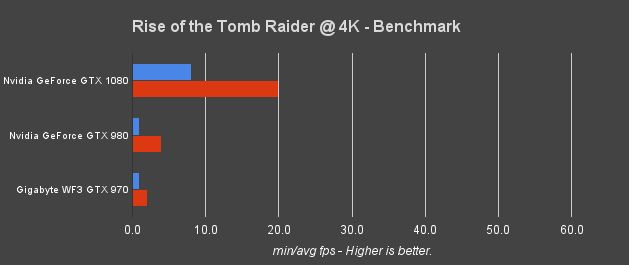
But it’s important to keep in mind I use the maximum anti-aliasing settings wherever possible, and these games are designed to be intensive on your system’s GPU. The reality is however that at 4K the pixel density within your screen is so high, you’ll need less aggressive AA to counter those dreaded jaggy pixels.
What this means is in reality you’ll see a lot less strain on your GPU and higher frame rates, outside of these fair, scientific and empirical testing methodologies I’ve utilised here.

What the GTX 1080 isn’t?
This isn’t Pascal’s final form, though. This is the GP104 architecture as opposed to the GP100 found in Nvidia’s HBM2.0 compatible Tesla series server cards. Think of GP104 as a scaled down variant on the Maxwell series architecture.
By no means is that a bad thing. After all the overclocking potential buried within this architecture was the best Nvidia has ever produced. And the same rings true here, but more on that later.
The AMD fans amongst you will undoubtedly be sneering at the lack of HBM memory on this temporary flagship, and yes whilst that is true, GDDR5X is still nothing to sneer at. With a 256-bit bus, a 10,000 MHz clock and 320GB/s bandwidth it’s more than capable of performing well at 4K and 1440p without any worry.
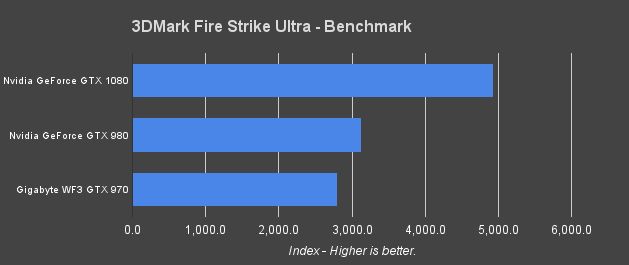
Overclocking
So, the Nvidia GTX 1080 is more powerful, has more transistors, an improved memory set, and generally kicks ass at 4K – but how far can we push it?
Well, similar to Nvidia’s last generation GTX 980, the Founder’s Edition GTX 1080 overclocked well. In testing we managed to get an extra 260 MHz out of the core clock, and 525 MHz on the memory clock.
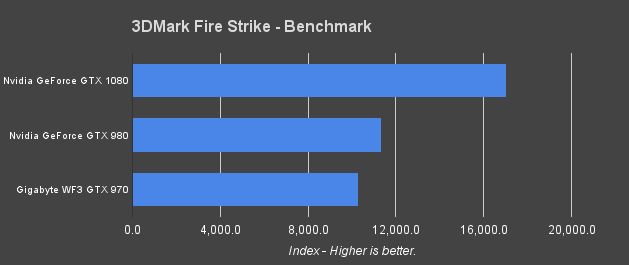
This all enabled an overall boost clock up to an astonishing 2,088 MHz, which in turn bumped our 3D Mark Firestrike scores up by well over a 1000 on each resolution. Impressive to say the least. On top of that, it really didn’t require that much more in the way of voltage, and remained stable and quiet throughout.
A solid win in our books.
Verdict
Ultimately our biggest problem with Nvidia’s GeForce GTX 1080 comes down to pricing. There’s an $80 premium on getting your hands on the card early. AIB partner’s retail prices will be far lower than that of the stock reference cooler.
In reality this doesn’t make much in the way of sense. The blower style shroud, although effective, lacks the necessary capacity to deal with higher overclocks at more acceptable temperatures.
On top of that, you can bet that a vast majority of the aftermarket cards will be overclocked as standard, meaning you’ll be getting better performance, with a more optimized cooler, for a lower price. Current word on the street is that we should be expecting aftermarket variants midway through June, two weeks after the 27th of May retail launch of the Founder’s Edition.
We Liked
In short the performance is exceptional, there’s no question that this is the most powerful single GPU out there to date. 4K gaming is joyous on this thing, and with a little tweaking to your AA settings, it’d be hard to imagine a title not capable of 60 fps on average. Couple that with what this means for the GTX 1080 Ti, and new generation of Titan that will soon be to follow, and well it’s definitely going to be one hell of a year for us graphics lovers.
We Disliked
The price for the Founder’s Edition. In short it’s nuts, and it makes this card almost unattainable for the average joe, which is a shame. No doubt over time, we’ll see this price point drop as AMD releases their Vega line of GPUs in October amongst other Polaris offerings, but until then it just pushes it slightly out of the range of an otherwise perfect product.
Final verdict
If we’re just evaluating the GPU itself, the Nvidia GTX 1080 is absolutely astounding. Delivering nearly double the performance of GTX 980 in nearly every game is astonishing. Couple that with its fantastic 4K performance, this might be the first card that makes UHD gaming a reality. With its low power draw, single 8 pin power, and classy design, it’s definitely one to consider if you’re thinking of either upgrading to a 144 Hz 1440p gaming monitor, or a single 4K panel.
That said, if you’re willing to sit it out for a few weeks to months, it won’t be long before aftermarket cards come with lower price tags and better specs.
Source: techradar.com










































Neither card is worth it? What a troll ..
Neither card is worth it …
it just so happens that the FE adds insult to injury.
the Ti's were over 1000 dollars when released….
I'll have to agree that the FE is expensive and not worth it. Once released, the partner companies will start rolling out those custom coolers that are better with the cards pre-overclocked and such making it more convenient and worth it for the amount you're paying for.
Happy with my MSI 970 LE over a reference one too. Just wait out for the partner's customized 1080 if you want something worth your money.
https://versus.com/en/nvidia-g…
Though not needing it fulling, the huge leap will definitely help big time.
I thought they were only about $50 more than the 980 (which dropped by a further $50 when the Ti released). Unless you're talking about the Titan(s).
I feel like the x80 price is slowly hiking up. I'm not sure if they'll do a 1080ti this gen, just because the 1080 looks like such a beast and there may not need to be a mid-ground between 1080 and new Titan. Last gen I think the 980ti was sorely needed because the 980 was in no-man's land – being too close in performance to the cheaper 970, and miles away from the Titan X.